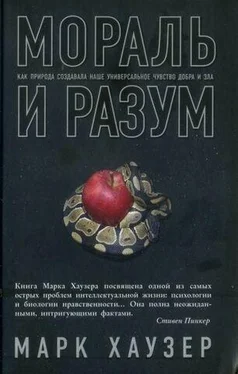Mischel W. (1974). Processes in delay of gratification // L. Berkowitz (Ed.), Advances in Experimental Social Psychology, Vol. 7 (p. 249—292). New York: Academic Press.
Mischel W. y Skoda Y & Rodriguez M. L. (1989). Delay of gratification in children // Science, 244 y 933—938.
Mischel W. y Zeiss R. & Zeiss A. (1974). Internal-external control and persistence: validation and implications of the Stanford preschool internal-external scale // Journal of Personality and Social Psychology, 29, 265—278.
Mock D. W. (2004). More Than Kin and Less Than Kind. Cambridge, MA: Harvard University Press.
Moliere J. B. P. (1673). Le Misanthrope. Oberon Books: London.
MollEslinger R J. & Oliviera-Souza R. (2001). Frontopolar and anterior temporal cortex activation in a moral judgment task: preliminary functional MRI results in normal subjects // Archives of Neuropsychiatry, 59, 657—664.
MollJ., Oliveira-Souza R. & Eslinger P. J. (2002). The neural correlates of moral sensitivity: a functional MRI investigation of basic and moral emotions //Journal of Neuroscience, 27, 2730—2736.
MollJ., Oliveira-Souza R., Moll F. T, Ignacio I. E., Caparelli-Daquer E. M. & Eslinger P. J. (2005). The moral affiliations of disgust. Working paper. Not yet published.
Moll J., Olivier-Souza R. & Bramati I. E. (2002). Functional networks in moral and non-moral social judgments // Neuro Image, 16 , 696—703.
Moore C. & Macgillivray S. (2004). Altruism, prudence, and theory of mind in preschoolers // New Directions for Child and Adolescent Development, 103 , 51— 62.
Moore G. E. (1903). Principia Ethica. Cambridge: Cambridge University Press.
Muller J. L., Sommer M., Wagner V, Lange К ., Taschler H., Roder C. H., Schuierer G., Klein H. E. & Hajak G. (2003). Abnormalities in emotion processing within cortical and subcortical regions in criminal psychopaths: evidence from a functional magnetic resonance imaging study using pictures with emotional content // Biological Psychiatry, 54, 152—163.
Munn C. (1986). Birds that “cry wolf” // Nature, 319 , 143—145.
Murnighan J . K. & Saxon M. S. (1998). Ultimatum bargaining by children and adults //Journal of Economic Psychology, 79, 415—445.
Nesse R. M. (Ed.). (2001). Evolution and the Capacity for Commitment. New York: Russell Sage Foundation.
Newport E. L. baAslin R. N. (2004). Learning at a distance. I. Statistical learning of non-adjacent dependencies // Cognitive Psychology, 48, 127—162.
Newtson D. (1973). Attribution and the unit of perception of ongoing behavior // Journal of Personality and Social Psychology, 28, 28—38.
Newtson D., Engquist G. & Bois J. (1977). The objective basis of behavior units // Journal of Personality and Social Psychology, 35, 847—862.
Newtson D., Hairfield Bloomingdale J. & Cutino S. (1987). The strucutre of action and interaction // Social Cognition, 5, 191—237.
Nichols S. (2002). Norms with feeling: toward a psychological account of moral judgment // Cognition, 84, 221—236.
Nichols S. (2004). Sentimental Rules. New York: Oxford University Press.
Nichols S. & Folds-Bennett T (2003). Are children moral objectivists? Children’s judgments about moral and response-dependent properties // Cognition, B23 — B32.
Nikulina E. M. (1991). Neural control of predatory aggression in wild and domesticated animals // Neuroscience and Biobehavioral Reviews, 15, 545—547.
Nisbett R. E. & Cohen D. (1996). Culture of Honor: The Psychology of Violence in the South. Boulder, CO: Westview Press.
Noe R. (1990). A veto game played by baboons: a challenge to the use of the Prisoner’s Dilemma as a paradigm of reciprocity and cooperation // Animal Behaviour, 39, 78—90.
Noe R., van Hoof J. A. R. A. M. & Hammerstein P (2001). Economics in Nature. Cambridge: Cambridge University Press.
Nourse V. (1997). Passion’s progress: modern law reform and the provocation defense // Yale Law Journal, 106, 1331—1344.
Nowak М. A., Page К. М. & Sigmund К. (2000). Fairness versus reason in the ultimatum game // Science, 289, 1773—1775.
Nowak M. A. & Sigmund K. (2000). Enhanced: Shrewd investments // Science, 288, 819.
Nucci L. (2001). Education in the Moral Domain. Cambridge: Cambridge University Press.
Nunez M. & Harris P L. (1998). Psychological and deontic concepts: separate domains or intimate connection? // Mind and Language, 13, 153—170.
Nusshaum M. (2004). Hiding from Humanity: Disgust, Shame, and the Law. Princeton, NJ: Princeton University Press.
O'Neill P & Petrinovich L. (1998). A preliminary cross cultural study of moral intuitions // Evolution and Human Behavior, 19, 349—367.
Ohman A., Flykt A. & Esteves F (2001). Emotion drives attention: Detecting the snake in the grass // Journal of Experimental Psychology: General, 130, 466— 478.
Oliveira Souza R. & Moll J. (2000). The moral brain: a functional MRI study of moral judgment // Neurology, 54, 1331—1336.
Olson J. M., Roese N. J. & Zanna M. P (1996). Expectancies // E. T. Higgins & A. W Kruglanski (Eds.), Social Psychology: Handbook of Basic Principles (p. 211—238). New York: Guilford Press.
Olsson A., Ebert J. P, Banaji M. R. & Phelps E. A. (2005). The role of social groups in the persistence of learned fear // Science, 309, 711—713.
Onishi К. H. & Baillargeon R. (2005). Do 15-month-old infants understand false beliefs? // Science, 308, 255—257.
Packer C. (1977). Reciprocal altruism in olive baboons // Nature, 265, 441—443.
Packer C. & Pusey A. (1985). Asymmetric contests in social mammals: respect, manipulation and age-specific aspects // P J. Greenwood & P H. Harvey (Eds.), Evolution: Essays in Honour of John Maynard Smith (p. 173—186). Cambridge: Cambridge University Press.
Packer C. & Ruttan L. (1988). The evolution of cooperative hunting // American Naturalist, 132, 159—198.
Paladino M.-P, Leyens J.-P, Rodriguez R., Rodriguez A., Gaunt R. & Demoulin S. (2002). Differential association of uniquely and non-uniquely human emotions with the ingroup and outgroup // Group Processes and Intergroup Relations, 5, 105—117.
Parr L. A. (2001). Cognitive and psychological markers of emotional awareness in chimpanzees // Animal Cognition, 4, 223—229.
Patterson O. (1982). Slavery and Social Death. Cambridge, MA: Harvard University Press.
Peake P K., Mischel W. & Hebl M. (2002). Strategic attention deployment for delay of gratification in working and waiting situations // Developmental Psychology, 38(2), 313—326.
Peterson L., Hartmann D. P & Gelfand D. M. (1977). Developmental changes in the effects of dependency and reciprocity cues on children’s moral judgments and donation rates // Child Development, 48, 1331—1339.
Petrinovich L. & O'Neill P (1996). Influence of wording and framing effects on moral intuitions // Ethology and Sociobiology, 17, 145—171.
Читать дальше











